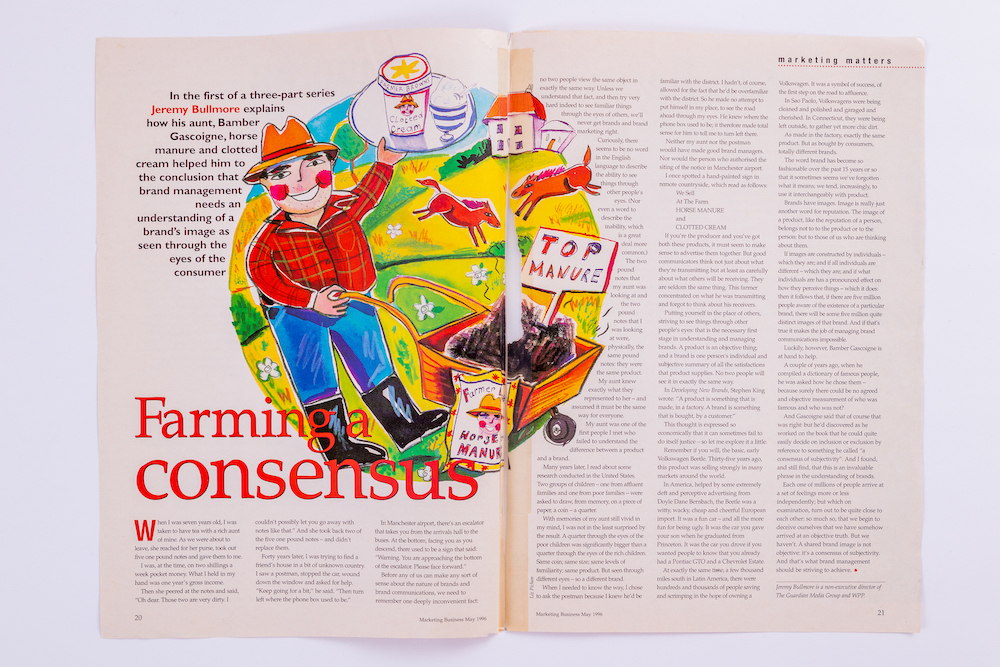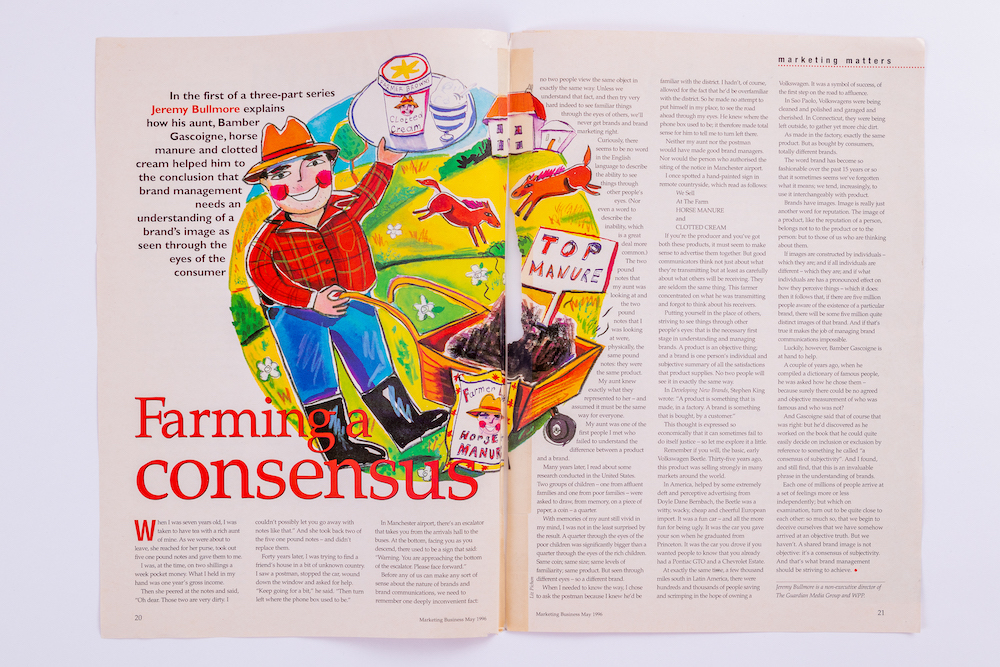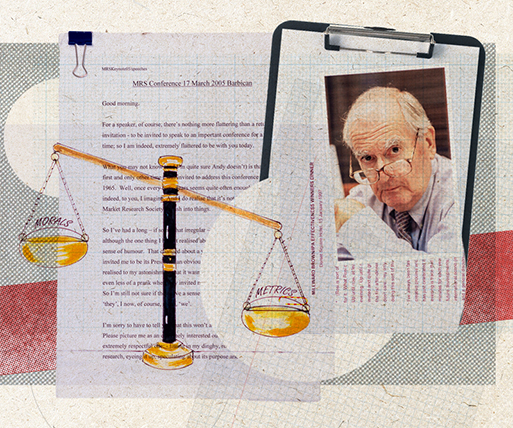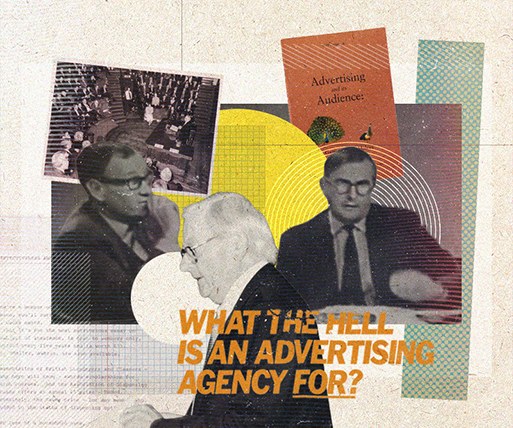Understanding Brands Part 1 – Farming a consensus, 1996
- Date: 1996
- Publisher: Marketing Business
- BRANDS
In these much-quoted features published in May, June and July 1996 Jeremy explores the basics of brands. Part 1 explores the skills of communicating brand benefits and values through the eyes of a consumer.
Understanding Brands Part 1 – Farming a consensus
When I was seven years old, I was taken to have tea with the only rich relation we had. As we were about to leave, she reached for her purse, took out five one pound notes and gave them to me.
I was, at the time, on two shillings a week pocket money. What I held in my hand was one year’s gross income.
Then she peered at the notes and said, “Oh dear. Those two are very dirty. I couldn’t possibly let you go away with notes like that.” And she took back two of the five one pound notes - and didn’t replace them.
Forty years later, I was trying to find a friend’s house in a bit of unknown country. I saw a postman, stopped the car, wound down the window and asked for help. “Keep going for a bit,” he said. “Then turn left where the phone box used to be.”
In Manchester Airport, there’s a down escalator that takes you from the arrivals hall to the buses. At the bottom of the elevator, facing you as you descend, there used to be a sign that said: “Warning. You are approaching the bottom of the escalator. Please face forward.”
Before any of us can make any sort of sense about the nature of brands and brand communications, we need to remember one deeply inconvenient fact: no two people view the same object in exactly the same way. Unless we understand that fact, and then try very hard indeed to see familiar things through the eyes of others, we’ll never get brands and brand marketing right.
Curiously, there seems to be no word in the English language to describe the ability to see things through other people’s eyes. (Nor even a word to describe the inability, which is a great deal more common. An acquaintance who is both a classicist and a Member of the Royal College of Psychologists suggests anheteropsia. Neither he nor I believe this likely to become part of popular currency.) Perhaps the absence of vocabulary is one key reason why this essential skill continues to be under-recognised.
The two pound notes that my aunt was looking at and the two pound notes that I was looking at were, physically, the same pound notes: they were the same product.
My aunt knew exactly what they represented to her - and assumed, as we all too often do - that the way she saw those notes must be the way that everyone, including me, saw those notes. To her, they meant little; and because they were dirty, they meant even less.
To the seven-year old me, those two pound notes represented five months’ income: unimaginable excesses; gluttonous quantities of Crunchies and sherbet fountains, Dandy, Beano, Champion and every other comic published; sheets of balsa wood, tubes of balsa-wood cement; and the new de Haviland Dinky toy.
My aunt was one of the first people I met who failed to understand the difference between a product and a brand.
Many years later, I read about some research conducted in the United States. Two groups of children had been recruited: one from affluent families and one from poor families. All the children from both groups were then asked to draw, from memory, on a piece of paper, a coin – a quarter.
With memories of my aunt still vivid in my mind, I was not in the least surprised by the result. A quarter through the eyes of the poor children was significantly bigger than a quarter through the eyes of the rich children. Same coin; same size; same levels of familiarity; same product. But seen through different eyes - so a different brand.
When I needed to know the way, I chose to ask the postman because I knew he’d be familiar with the district. I hadn’t, of course, allowed for the fact that he’d be overfamiliar with the district. So he made no attempt to put himself in my place, to see the road ahead through my eyes. He knew where the phone box used to be; it therefore made total sense for him to tell me to turn left there.
Neither my aunt nor the postman would have made good brand managers.
Nor would the person who authorised the siting of the notice in Manchester airport.
Good communicators think not just about what they’re transmitting but at least as carefully about what others will be receiving. They are seldom the same thing.
Putting yourself in the place of others, striving to see things through other people’s eyes: that is the necessary first stage in understanding and managing brands. A product is an objective thing; and a brand is one person's individual and subjective summary of all the satisfactions that product supplies. No two people will see it in the same way.
In “Developing New Brands”, Stephen King wrote: “A product is something that is made, in a factory. A brand is something that is bought, by a customer.”
This thought is expressed so economically that it can sometimes fail to do itself justice - so let me explore it a little.
Thirty-five years ago, the Volkswagen Beetle was selling strongly in many markets around the world.
In America, helped by some extremely deft and perceptive advertising from Doyle Dane Bernbach, the Beetle was a witty, wacky, cheap and cheerful European import. It was a fun car - and all the more fun for being ugly. It was the car you gave your son when he graduated from Princeton. It was the car you drove if you wanted people to know that you already had a Pontiac GTO and a Chevrolet Estate.
That was the blend of satisfactions delivered by this object to those people in affluent North America, round about 1960.
At exactly the same time, a few thousand miles south in Latin America, there were hundreds and thousands of people saving and scrimping also in the hope of graduating - but not from Princeton. They were hoping to graduate from their bicycle, their moped or their second-hand banger to their first, new, never-owned-by-anyone- else-before car.
And the absolute height of their ambitions was a Volkswagen. It was both expensive and luxurious. It would be a symbol to themselves and others of success, of arrival, of the first step on the road to affluence.
In Sao Paolo, Volkswagens were being cleaned and polished and garaged and cherished. In Connecticut, they were being left outside, to gather yet more chic dirt.
As made in the factory, exactly the same product.
But as bought by consumers, totally different brands.
The word brand has become so fashionable over the last fifteen years or so that it sometimes seems we’ve forgotten what it means; we tend, increasingly, to use it interchangeably with product.
Brands have images. Image is just another word for reputation. The image of a product, like the reputation of a person, belongs not to the product or to the person: but to those of us who are thinking about them.
If images are constructed by individuals - which they are; and if all individuals are different - which they are; and if what individuals are has a pronounced effect on how they perceive things - which it does: then it follows that, if there are five million people aware of the existence of a particular brand, there will be some five million quite distinct images of that brand.
And if that’s true, which it is, it makes the job of managing brand communications impossible.
Luckily, however, Bamber Gascoigne is at hand to help. A couple of years ago, when he compiled a dictionary of famous people, he was asked how he chose them - because surely there could be no agreed and objective measurement of who was famous and who was not?
And Gascoigne said that of course that was right: but he’d discovered as he worked on the book that he could quite easily decide on inclusion or exclusion by reference to something he called ‘a consensus of subjectivity’. And I found, and still find, that this is an invaluable phrase in the understanding of brands.
Each one of millions of people arrives at a set of feelings more or less independently; but which on examination, turn out to be quite close to each other: so much so, that we begin to deceive ourselves that we have somehow arrived at an objective truth. But we haven’t. A shared brand image, like a shared view about Elle MacPherson or Matisse, is not objective: it’s a consensus of subjectivity. And that’s what brand management should be striving to achieve.
Part 2




